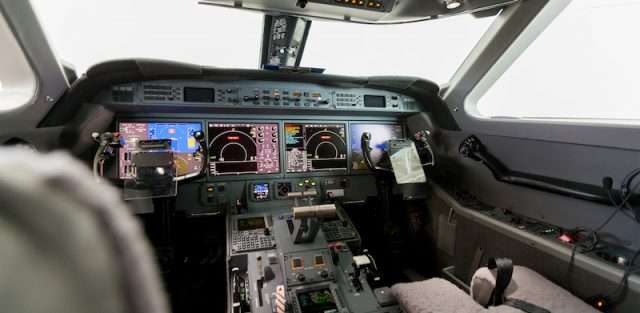Aeronautical Chart

An aeronautical chart is used by pilots to facilitate the safe navigation of air charter flights. Similar to a driver using a roadmap, a pilot can use an aeronautical chart to get from Point A to Point B, safely and efficiently. They allow pilots to:
- Determine their position
- Find the best route to a given destination
- Establish a safe cruising altitude
- Identify NAVAIDS (navigational aids) along the way
Aeronautical charts also feature topographic features, hazards and obstructions, designated airspace, radio frequencies and surrounding airports. In addition to the intended destination airport, aeronautical charts will also reference nearby airports in case the pilot needs to reroute the flight plan for any reason (such as inclement weather or air traffic congestion at the intended airport. Alternate airports can also be used to make an emergency landing.
Different Types of Aeronautical Charts
Similar to topographical maps, aeronautical charts are available in different scales, which allow them to cover different geographical areas. This way, flight crews are able to choose the scale of map that best suits the distance they are scheduled to travel. Additionally, there are charts for all landmasses on earth. Private jet charter crews always ensure to have the charts available for every section of land that they will pass over. Some of the more commonly used aeronautical charts include:
VFR
A VFR aeronautical chart is a sectional aeronautical chart (or sectional) used by pilots flying under Visual Flight Rules. The scale of these charts needs to be large enough to be read easily by pilots, usually around 1:500,000. For ease of use, these charter are named after a major city within its coverage area.
VFR Flyway Planning Charts
Flyway Planning Charts help pilots identify recommended flight paths and altitudes in areas where a lot of commercial air traffic exists. These charts are printed on the back of Terminal Area Charts for major cities across the United States (Baltimore-Washington, Dallas-Ft. Worth, Los Angeles, Miami etc.)
Terminal Area Charts
Terminal area charts are used for VFR navigation in areas surrounding major airports.
IFR Enroute Low Altitude
provide aeronautical information for navigation under instrument flight rules below 18,000 feet.
IFR Enroute High Altitude
IFR Enroute High Altitude Charts are designed for navigation across the continental US and Alaska when flying at or above 18,000 feet.
Oceanic Route Planning Charts
These charts depict established intercontinental air routes, including reporting points with geographic positions.
Terminal Procedure Publications
U.S. Terminal Procedures Publications cover the continental U.S., Puerto Rico and the Virgin Islands. They contain charts depicting approach and departure procedures for both instrument and visual flying.
An aeronautical chart is used by pilots to facilitate the safe navigation of air charter flights. Similar to a driver using a roadmap, a pilot can use an aeronautical chart to get from Point A to Point B, safely and efficiently. They allow pilots to:
- Determine their position
- Find the best route to a given destination
- Establish a safe cruising altitude
- Identify NAVAIDS (navigational aids) along the way
Aeronautical charts also feature topographic features, hazards and obstructions, designated airspace, radio frequencies and surrounding airports. In addition to the intended destination airport, aeronautical charts will also reference nearby airports in case the pilot needs to reroute the flight plan for any reason (such as inclement weather or air traffic congestion at the intended airport. Alternate airports can also be used to make an emergency landing.
Different Types of Aeronautical Charts
Similar to topographical maps, aeronautical charts are available in different scales, which allow them to cover different geographical areas. This way, flight crews are able to choose the scale of map that best suits the distance they are scheduled to travel. Additionally, there are charts for all landmasses on earth. Private jet charter crews always ensure to have the charts available for every section of land that they will pass over. Some of the more commonly used aeronautical charts include:
VFR
A VFR aeronautical chart is a sectional aeronautical chart (or sectional) used by pilots flying under Visual Flight Rules. The scale of these charts needs to be large enough to be read easily by pilots, usually around 1:500,000. For ease of use, these charter are named after a major city within its coverage area.
VFR Flyway Planning Charts
Flyway Planning Charts help pilots identify recommended flight paths and altitudes in areas where a lot of commercial air traffic exists. These charts are printed on the back of Terminal Area Charts for major cities across the United States (Baltimore-Washington, Dallas-Ft. Worth, Los Angeles, Miami etc.)
Terminal Area Charts
Terminal area charts are used for VFR navigation in areas surrounding major airports.
IFR Enroute Low Altitude
provide aeronautical information for navigation under instrument flight rules below 18,000 feet.
IFR Enroute High Altitude
IFR Enroute High Altitude Charts are designed for navigation across the continental US and Alaska when flying at or above 18,000 feet.
Oceanic Route Planning Charts
These charts depict established intercontinental air routes, including reporting points with geographic positions.
Terminal Procedure Publications
U.S. Terminal Procedures Publications cover the continental U.S., Puerto Rico and the Virgin Islands. They contain charts depicting approach and departure procedures for both instrument and visual flying.








